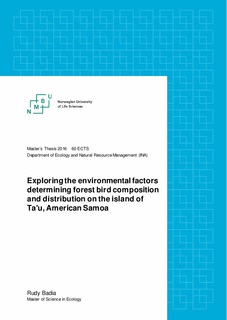| dc.contributor.advisor | Haugaasen, Torbjørn | |
| dc.contributor.author | Badia, Rudy | |
| dc.coverage.spatial | South Pacific | nb_NO |
| dc.date.accessioned | 2017-03-23T12:53:43Z | |
| dc.date.available | 2017-03-23T12:53:43Z | |
| dc.date.issued | 2016 | |
| dc.identifier.uri | http://hdl.handle.net/11250/2435194 | |
| dc.description.abstract | Basic biological knowledge tends to decrease when one moves from the poles and towards the equator. The most diverse habitat also happens to be centered near the equator and where much conservation initiatives are needed. The following study aims to explore the environmental factors determining avian community composition and distribution across forest habitats on the Pacific island of Ta'u, American Samoa. Fixed radius counts were conducted and habitat structure assessments performed to determine the effect of vegetation on the bird assemblages and occurrence of individual bird species. An NMDS ordination was conducted to investigate bird species abundance. It was observed that the assemblages of vegetational structure on the lowland rainforest, montane and summit scrub habitat are very structured with certain forest birds showing preferences towards them. While disturbed habitat tended to consist much of the island of Ta’u containing a much more varied composition with generalist bird abundant there. General Linear Models (GLM) were used to assess the effect of habitat characteristics on bird assemblage structure and distribution of individual species. Results show that native and introduced vegetation had an effect on the bird distribution, but that the effect differed between individual species and by habitat type. 43% of all the detected landbird individuals were on disturbed habitats, perhaps due to the bird movements between
rainforest habitats and disturbed sites. Since Ta'u does not harbour any nonnative forest bird species, those birds could be filling the disturbed/modified habitats. Of conservation concern due to the restricted home range, habitat preference and recently described full specie, the Manu'a Shrikebill (Clytorhynchus powelli) was strongly observed to be associated with native habitats. Such habitat was seen to be altered by human activity and feral animals. The study emphasizes the need for additional research to fully understand the forest bird-environmental interactions to direct future conservation initiatives for the island of Ta'u. In addition, management and protection of the altered but diverse lowland environment is needed to allow those habitats of the island to be preserved. | nb_NO |
| dc.language.iso | eng | nb_NO |
| dc.publisher | Norwegian University of Life Sciences, Ås | nb_NO |
| dc.rights | Attribution-NonCommercial-NoDerivatives 4.0 Internasjonal | * |
| dc.rights.uri | http://creativecommons.org/licenses/by-nc-nd/4.0/deed.no | * |
| dc.title | Exploring the environmental factors determining forest birds composition and distribution on the island of Ta'u, American Samoa | nb_NO |
| dc.type | Master thesis | nb_NO |
| dc.subject.nsi | VDP::Mathematics and natural science: 400::Zoology and botany: 480::Ecology: 488 | nb_NO |
| dc.source.pagenumber | 56 | nb_NO |
| dc.description.localcode | M-ECOL | nb_NO |

